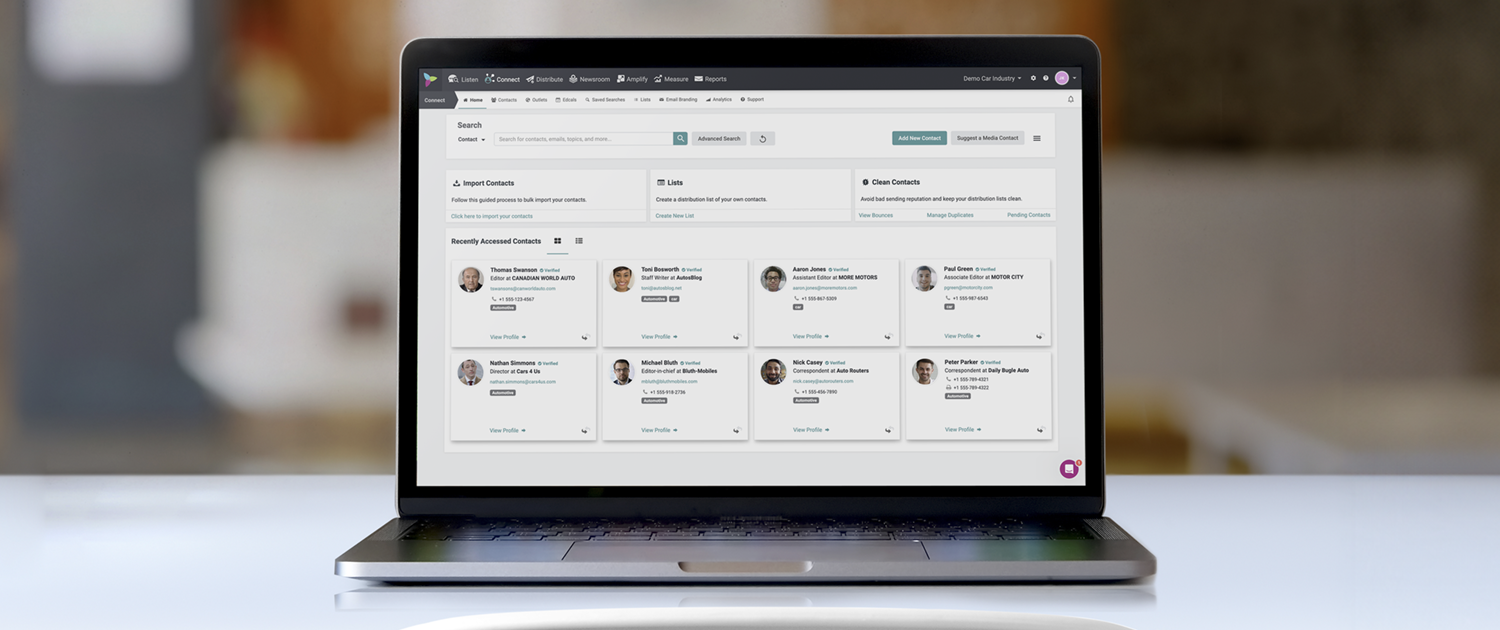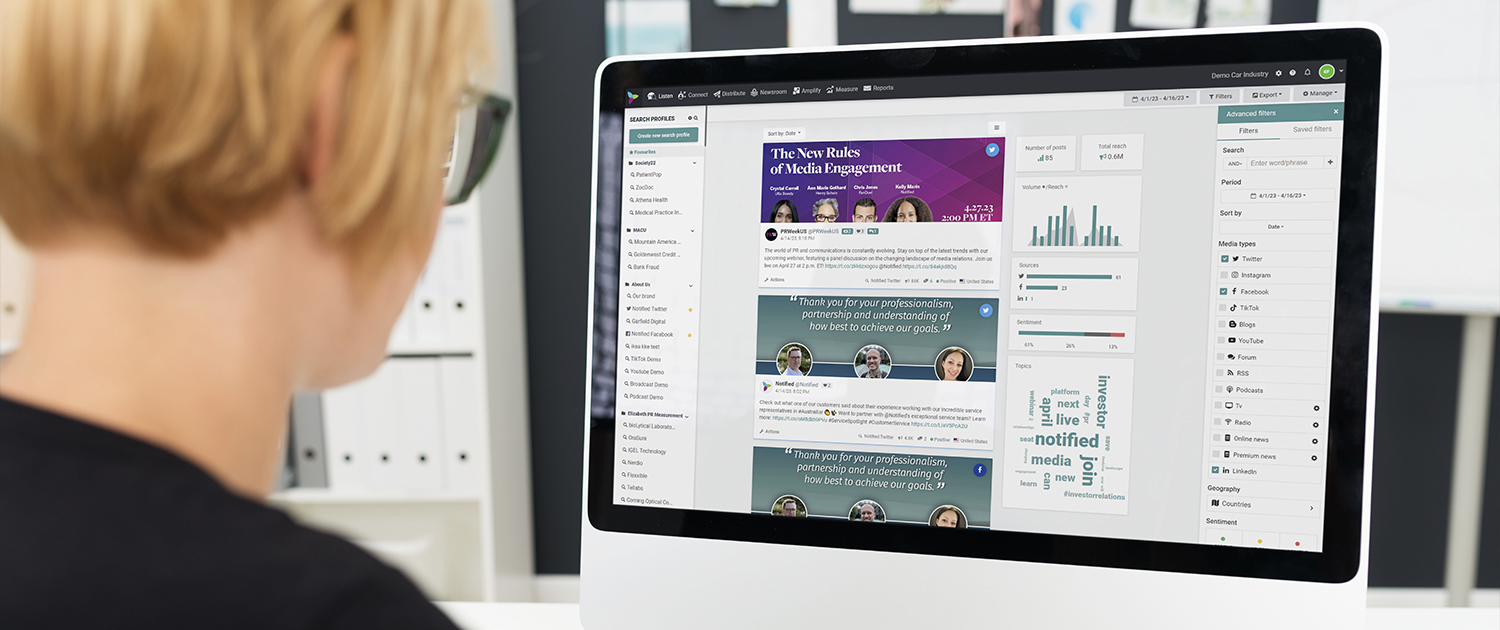Share this
What Is a Media Database? And Why Is It Important for PR?
by The Notified Team on Nov 7, 2023 3:55:22 PM
When it comes to amplifying brand stories, gaining the attention of journalists is a crucial step in creating awareness and extending reach. But how do you target the right media contacts who might be interested in your story?
Instead of searching the internet for these individuals, you can use a media contacts database to quickly find and connect with those who are most interested in what you have to say.
In this blog, we'll provide a detailed explanation of what a media database is, why it's important, its key benefits and what to look for when selecting a tool.
Keep reading to learn more!

What Is a Media Database?
A media database is a collection of information about various contacts - outlets (of all media types), journalists, reporters, editors and other professionals - who work in the media industry. Once you’ve identified these individuals, you can then add them to your press release distribution lists.
Media types include newspapers, magazines, TV stations, radio stations, internet publications, newsletters, blogs, journals, podcasts and more.
Media databases provide various details about each contact, giving a comprehensive overview of their profile.
Here's what you can expect to find for each contact in a database:
- Contact Name: This includes the full names of the media professionals or journalists, ensuring accurate identification.
- Work Title: The position or job role held by the contact within their organization.
- Contact Information: This typically involves essential contact details such as email addresses and phone numbers, enabling direct communication.
- Contact Location: Contains publicly available address or location information for the contact, typically found in their website bio or social media profiles. It aids in the precise targeting of contacts based on their geographical location.
- Beats: The specific topics or subject areas that the contact covers or specializes in. For journalists, this helps in targeting the right individuals for pitching stories related to specific industries or interests.
- Media Outlets: Information about the media outlets or organizations that the contact is affiliated with. This may include the name of the publication, broadcasting station or online platform.
- Social Media Profiles: Links to the contact's social media accounts, including X (formerly Twitter), LinkedIn, Facebook, Instagram or personal blogs. Monitoring their social media activity can provide insights into their interests and current work.
- Biographical Information: A brief biography or background information about the contact, which can provide context about their education, career, expertise and any awards or recognitions they've received.
- Contact Preferences: Information about how the contact prefers to be contacted, their preferred communication methods (email, phone) and any specific instructions or preferences they have for receiving pitches or press releases.
- Media Moves: This includes tracking any changes within the media industry, including individuals leaving their current positions, transitioning to new outlets and new additions to media organizations.
Why Is a Media Database Important for Public Relations?
Using a media database offers several advantages for public relations pros. While it's possible to research media contacts manually, a database streamlines the process and saves time.
Today, most media contact databases are developed by combining AI and technology-driven solutions with manual research efforts. This approach involves the use of automated tools and expert human input to create a resource that is accurate, up-to-date and customized.
AI-powered databases (such as the one in the Notified PR Platform) automatically pinpoint influential, relevant journalists by looking at their past work, interests and what they write about. It also keeps track of what journalists are doing now, so your pitches stay up to date.
It also helps you create lists of media contacts that are specific to your needs, so you're more likely to get replies and have people read what you send them.
With a media contacts database, you can:
- Save Time: Researching contacts manually can be time-consuming. A database provides readily available information, allowing you to focus on crafting pitches and reaching out to journalists.
- Access Editorial Calendars: Subscribers can access editorial calendars to identify potential opportunities that align with PR initiatives.
- Templates for Customized Pitches: Some databases offer templates to help PR professionals create customized pitches (such as Enriched Email), which are more likely to receive positive responses from journalists.
- Track Outreach Efforts: You can track your outreach efforts within the platform, including who you've contacted, when you sent pitches to and the responses received.
- Efficient Communication: Quick access to accurate contact details ensures your messages reach media professionals promptly.
- Relationship Building: You can track past interactions and preferences to nurture long-term relationships with journalists.
- Media Monitoring: Media databases found within PR software can also include tools for monitoring media coverage. You can track mentions of your organization, brand or specific keywords in the media, helping you measure the effectiveness of your PR efforts.
- The Notified PR Platform pinpoints relevant journalists based on the monitoring you’ve done. Set up a new search to quickly uncover relevant contacts and augment your list with contacts you find in the database.
- The Notified PR Platform pinpoints relevant journalists based on the monitoring you’ve done. Set up a new search to quickly uncover relevant contacts and augment your list with contacts you find in the database.
- Crisis Management: During crises or urgent media inquiries, a well-organized media database is invaluable. It helps you communicate quickly and reach the right contacts.
- Content Distribution: When you create press releases, articles or other content for media consumption, a database can help facilitate the distribution of this content to relevant outlets and journalists.
- Get Timely Updates: Media landscapes are constantly evolving, with journalists changing jobs or roles and media outlets undergoing transformations. A media contacts database can be regularly updated to reflect these changes, ensuring that you always have the most accurate and current information.
However, it's essential to remember that the key to building successful media relationships is not just collecting data - but using it effectively to foster professional relationships.
While databases provide valuable tools, the primary focus should always be on creating value for journalists and building strong, mutually beneficial connections.
What Should You Consider Before Choosing a Media Database?
Before selecting a media database, it's necessary to conduct a thorough analysis to ensure you're investing in the right tool for your specific needs.
Here are some key factors to consider when evaluating databases:
- Data Accuracy and Quality: Verify the accuracy and quality of the contact information in the database. Outdated or incorrect contact details can lead to wasted outreach efforts and damage your media relations.
- Coverage and Relevance: Determine if the database includes a comprehensive list of media outlets, journalists and bloggers who are relevant to your industry, niche or target audience.
- Search and Filtering Capabilities: Evaluate the database's search and filtering features. It should allow you to easily segment contacts based on criteria like beat, location, media type and more to target your outreach effectively.
- Updates and Maintenance: Inquire about the frequency of database updates and maintenance. Media landscapes change rapidly, so regular updates are crucial to ensure you have current contact information.
- User-Friendly Interface: Ensure that the database has an insightful and user-friendly interface. Easy navigation and a well-designed dashboard will save you time and frustration.
- Data Privacy and Compliance: Confirm that the database provider adheres to data privacy regulations, such as GDPR, and provides features for managing consent and opt-out preferences.
- Customer Support and Training: Assess the level of customer support and training offered by the database provider. Adequate support can be crucial for resolving issues and maximizing the database's potential.
- Pricing and Licensing: Understand the pricing structure and licensing options. Some databases charge based on the number of users or the level of access, so choose a plan that aligns with your budget and requirements.
- Reviews and References: Research customer reviews and seek references from organizations or professionals who have used the database. This can provide insights into real-world experiences with the product.
- Data Security: Inquire about the security measures in place to protect the database's data. Data breaches can have serious consequences, so robust security is essential.
By thoroughly analyzing these factors and comparing different options, you can make an informed decision that aligns with your organization's goals and PR strategy.
We hope this article provides helpful insights into how a media contacts database can help transform your media outreach!

Learn More About the Media Contacts Database in the Notified PR Platform
Discover how Notified’s Media Contacts Database makes PR easier by providing quick access to updated, global contacts that enhance your media pitching and make work more efficient.
Take the tour and see how it can help amplify your story!
Share this
- Public Relations (224)
- Press Releases (115)
- Press Release Distribution (94)
- GlobeNewswire (90)
- Investor Relations (88)
- PR Communications (74)
- Artificial Intelligence (71)
- Media Relations (50)
- IR Communications (41)
- Media Contacts Database (40)
- Global News Distribution (32)
- Webinar (32)
- IR Websites (30)
- Earnings Calls (22)
- Notified PR Platform (21)
- IR Webcasts (19)
- Experiences (17)
- Studio Webinar Platform (17)
- Virtual Events (17)
- Writing Tips (17)
- Case Study (16)
- PR Trends (16)
- Webcasts (16)
- PR Measurement (15)
- Generative AI (13)
- Media Monitoring (13)
- Event Technology (12)
- Investor Days (12)
- Webinar Strategy (12)
- ESG (10)
- Social Media (10)
- IR Event Platform (9)
- Newswire (9)
- United Kingdom (9)
- Virtual Event Platform (9)
- Accessibility (8)
- Earnings Day (8)
- Earnings Release (8)
- News Roundup (8)
- Regulatory Filing (8)
- Germany (6)
- Report (6)
- Social Listening (6)
- CLEAR Verified (5)
- IR Hub (5)
- Video (5)
- Webinar Engagement (5)
- Brand Storytelling (4)
- Misinformation (4)
- PR Agency (4)
- SEO (4)
- Trust (4)
- IR Trends (3)
- Journalism (3)
- AGM (2)
- Awards (2)
- Branding (2)
- CSR (2)
- Capital Narratives (2)
- DEI (2)
- Demand Generation (2)
- Insights & Analytics (2)
- ROI (2)
- Sentiment Analysis (2)
- Webhosting (2)
- Annual General Meeting (1)
- Canada (1)
- Emojis (1)
- Equiniti (1)
- Events (1)
- France (1)
- Halloween (1)
- Internal Communications (1)
- Internships (1)
- Life At Notified (1)
- Mark Cuban Foundation AI Bootcamp (1)
- Marketing (1)
- News Briefs (1)
- News Releases (1)
- PRSA ICON (1)
- Product Launch (1)
- Retail Investors (1)
- SXSW (1)
- Share of Voice (1)
- Sponsorships (1)
- Success Story (1)
- White Paper (1)
- eBook (1)
- September 2025 (3)
- August 2025 (6)
- July 2025 (9)
- June 2025 (12)
- May 2025 (9)
- April 2025 (11)
- March 2025 (11)
- February 2025 (6)
- January 2025 (12)
- December 2024 (12)
- November 2024 (12)
- October 2024 (14)
- September 2024 (15)
- August 2024 (14)
- July 2024 (14)
- June 2024 (14)
- May 2024 (12)
- April 2024 (13)
- March 2024 (13)
- February 2024 (15)
- January 2024 (11)
- December 2023 (7)
- November 2023 (13)
- October 2023 (14)
- September 2023 (7)
- August 2023 (8)
- July 2023 (7)
- June 2023 (8)
- May 2023 (8)
- April 2023 (5)
- March 2023 (5)
- February 2023 (8)
- January 2023 (9)


